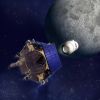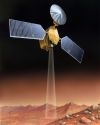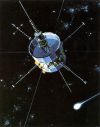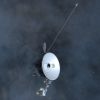Emily Lakdawalla • Oct 01, 2009
What's up in the solar system in October 2009
Phew! With the MESSENGER flyby over, I can focus now on what's ahead for October. The biggest thing to look forward to, without a doubt, is the planned smash of LCROSS into the Moon, a week from Friday, in the wee hours of the morning (my time) on October 9. However, I'm also excited about the fact that the next flyby of Titan will return Cassini to an orbit in the ring plane so it'll be seeing icy moons regularly again.In the inner solar system: After safing following the flyby, MESSENGER is back to "normal mode" but its science command load for the flyby period was permanently cancelled. New science will start on October 3, including some distant departure imagery of Mercury. I'm sure we'll see daily image releases from the team for a week or so, then they'll return to weekly announcements. They have to pace themselves; nothing of much significance will happen on the mission until Mercury orbit insertion on March 18, 2011.
After safing following the flyby, MESSENGER is back to "normal mode" but its science command load for the flyby period was permanently cancelled. New science will start on October 3, including some distant departure imagery of Mercury. I'm sure we'll see daily image releases from the team for a week or so, then they'll return to weekly announcements. They have to pace themselves; nothing of much significance will happen on the mission until Mercury orbit insertion on March 18, 2011.
 ESA's Venus Express is still in orbit at Venus; its current mission extension runs out on December 31, 2009, but the mission is expected to receive another extension in October taking it through three more years. If it remains healthy, it should therefore still be operating when JAXA's "Planet-C" Venus Climate Orbiter arrives in 2011.
ESA's Venus Express is still in orbit at Venus; its current mission extension runs out on December 31, 2009, but the mission is expected to receive another extension in October taking it through three more years. If it remains healthy, it should therefore still be operating when JAXA's "Planet-C" Venus Climate Orbiter arrives in 2011.
 So now NASA's Lunar Reconnaissance Orbiter and its companion craft LCROSS are the only active spacecraft left at the Moon. LRO is (as of September 15) in its final science orbit, but they haven't yet released any images from their new, closer perspective.
So now NASA's Lunar Reconnaissance Orbiter and its companion craft LCROSS are the only active spacecraft left at the Moon. LRO is (as of September 15) in its final science orbit, but they haven't yet released any images from their new, closer perspective.
 LCROSS is now falling toward the Moon for its date with destiny. Its Centaur upper launch stage will crash into the crater Cabeus on October 9 at 4:30 Pacific time / 11:30 UTC (not Cabeus A, as previously announced), and the spacecraft itself will follow behind on its own collision course to a spot about 3 kilometers away, principal investigator Tony Colaprete has told me.
LCROSS is now falling toward the Moon for its date with destiny. Its Centaur upper launch stage will crash into the crater Cabeus on October 9 at 4:30 Pacific time / 11:30 UTC (not Cabeus A, as previously announced), and the spacecraft itself will follow behind on its own collision course to a spot about 3 kilometers away, principal investigator Tony Colaprete has told me.
At the Sun: The ESA/NASA SOHO mission continues to gaze at a very quiet Sun, though late last month, for the first time in, like, forever, there were two sunspots visible at the same time. As always, SOHO's near-real-time data and images are available here. NASA reports that due to the lengthy solar minimum, cosmic ray levels are at record highs.
The ESA/NASA SOHO mission continues to gaze at a very quiet Sun, though late last month, for the first time in, like, forever, there were two sunspots visible at the same time. As always, SOHO's near-real-time data and images are available here. NASA reports that due to the lengthy solar minimum, cosmic ray levels are at record highs.
 The twin STEREO spacecraft are currently 61 degrees ahead (STEREO A) and 57 degrees behind (STEREO B) Earth and are also enjoying quiet weather conditions. They've gotten far enough apart that the mission homepage now features a neat rotating view of the two spacecraft's images that covers nearly the entire Sun. The daily STEREO image viewer includes the latest SOHO image, which gives you three slightly different viewpoints on the current appearance of the Sun. Currently SOHO sees the two sunspots I mentioned earlier, and so does STEREO Ahead, but STEREO Behind shows no sunspots.
The twin STEREO spacecraft are currently 61 degrees ahead (STEREO A) and 57 degrees behind (STEREO B) Earth and are also enjoying quiet weather conditions. They've gotten far enough apart that the mission homepage now features a neat rotating view of the two spacecraft's images that covers nearly the entire Sun. The daily STEREO image viewer includes the latest SOHO image, which gives you three slightly different viewpoints on the current appearance of the Sun. Currently SOHO sees the two sunspots I mentioned earlier, and so does STEREO Ahead, but STEREO Behind shows no sunspots.
On to Mars: Out at Mars, it's late summer in Mars' southern hemisphere (Ls 347°). As I wrote yesterday, Mars Exploration Rover Opportunity has been driving, driving, driving lately, while Spirit's still stuck. JPL's "Free Spirit" website is sounding slightly less sanguine than in the past: "Tests on Earth simulating Spirit's predicament on Mars have reinforced understanding that getting Spirit to rove again will be very difficult." This may all be part of the art of managing expectations, but as days drag on it's getting more difficult to remain optimistic. JPL engineers have snatched success from the jaws of defeat before, though. And in her latest update on the rovers, Here's A. J. S. Rayl reports that they have settled on an extraction plan!
Out at Mars, it's late summer in Mars' southern hemisphere (Ls 347°). As I wrote yesterday, Mars Exploration Rover Opportunity has been driving, driving, driving lately, while Spirit's still stuck. JPL's "Free Spirit" website is sounding slightly less sanguine than in the past: "Tests on Earth simulating Spirit's predicament on Mars have reinforced understanding that getting Spirit to rove again will be very difficult." This may all be part of the art of managing expectations, but as days drag on it's getting more difficult to remain optimistic. JPL engineers have snatched success from the jaws of defeat before, though. And in her latest update on the rovers, Here's A. J. S. Rayl reports that they have settled on an extraction plan!
 Mars Reconnaissance Orbiter is still in safe mode. Word from a friend at JPL is that they are being super extra cautious with trying to troubleshoot the computer reboots, because for the foreseeable future Mars Reconnaissance Orbiter is the only telecommunications relay we're going to have for future Mars landers (yes, Odyssey is still operating, but that spacecraft is a decade old and can't be relied upon to last forever either). It's frustrating to scientists because as time goes on, dawn is progressively arriving at farther and farther northern locations, and they would really like to be able to watch the northern wastes thaw out. There was a terribly cool announcement from three Mars Reconnaissance Orbiter teams about finding brand-new craters that punch into subsurface ice, which is then observed to sublimate away, which I have been meaning to write about, but have not had time to write about yet. Sorry! Another casualty of the persistent safe mode has been the MARCI team's continuous observation of Mars weather. On the MARCI weather report website, it states that, as of September 6, "The MARCI camera was turned off last week, and no new MARCI data will be available until the latter half of October. Please check back then for an updated weather report." Still no CRISM image releases for over a year.
Mars Reconnaissance Orbiter is still in safe mode. Word from a friend at JPL is that they are being super extra cautious with trying to troubleshoot the computer reboots, because for the foreseeable future Mars Reconnaissance Orbiter is the only telecommunications relay we're going to have for future Mars landers (yes, Odyssey is still operating, but that spacecraft is a decade old and can't be relied upon to last forever either). It's frustrating to scientists because as time goes on, dawn is progressively arriving at farther and farther northern locations, and they would really like to be able to watch the northern wastes thaw out. There was a terribly cool announcement from three Mars Reconnaissance Orbiter teams about finding brand-new craters that punch into subsurface ice, which is then observed to sublimate away, which I have been meaning to write about, but have not had time to write about yet. Sorry! Another casualty of the persistent safe mode has been the MARCI team's continuous observation of Mars weather. On the MARCI weather report website, it states that, as of September 6, "The MARCI camera was turned off last week, and no new MARCI data will be available until the latter half of October. Please check back then for an updated weather report." Still no CRISM image releases for over a year.
 ESA's Mars Express is still diligently mapping Mars. The Mars Webcam is currently returning high-phase shots of Mars, including some with some high clouds visible on the terminator. They have also posted a nice color version of a recent Mars photo along with a detailed explainer on how it was made -- check it out and try it for yourself! Mars Express' current mission extension takes it through December 31 -- like Venus Express, it's expected to be extended further.
ESA's Mars Express is still diligently mapping Mars. The Mars Webcam is currently returning high-phase shots of Mars, including some with some high clouds visible on the terminator. They have also posted a nice color version of a recent Mars photo along with a detailed explainer on how it was made -- check it out and try it for yourself! Mars Express' current mission extension takes it through December 31 -- like Venus Express, it's expected to be extended further.
 NASA's Mars Odyssey remains the longest-lived spacecraft in orbit at Mars. You can see the latest from its THEMIS instrument here Lately the theme to their images has been dunes, dunes, and more dunes, making gorgeous repeating patterns on the Martian surface.
NASA's Mars Odyssey remains the longest-lived spacecraft in orbit at Mars. You can see the latest from its THEMIS instrument here Lately the theme to their images has been dunes, dunes, and more dunes, making gorgeous repeating patterns on the Martian surface.
Exploring Saturn: Cassini is continuing to watch sunrise on the northern face of Saturn's rings after last month's equinox. There was a lull in activity last month as Saturn passed through conjunction, but raw images are now coming back again, including more neat ones of a distant but fully lit Iapetus and tons and tons of images of spokes. Cassini is now wrapping up rev 118 of its tour. The orbit period is stil 24 days, but a targeted flyby of Titan on October 12 will shrink the orbit again. More importantly, the gravity assist provided by that flyby will drop Cassini's orbit back into the plane of Saturn's rings, affording it many, many more opportunities for close encounters with the other moons than it's had lately. (Though it probably also means that the spectacular ring phenomena we've been watching throughout equinox season will be much, much harder to see -- I'm not sure what, if anything, will be visible from the new, edge-on view.) This month will see nontargeted flybys of Rhea, Mimas, and Tethys in quick succession on October 13 and 14. Looking ahead, in a month, on November 2, comes the first of two very, very close targeted flybys of Enceladus.
Cassini is continuing to watch sunrise on the northern face of Saturn's rings after last month's equinox. There was a lull in activity last month as Saturn passed through conjunction, but raw images are now coming back again, including more neat ones of a distant but fully lit Iapetus and tons and tons of images of spokes. Cassini is now wrapping up rev 118 of its tour. The orbit period is stil 24 days, but a targeted flyby of Titan on October 12 will shrink the orbit again. More importantly, the gravity assist provided by that flyby will drop Cassini's orbit back into the plane of Saturn's rings, affording it many, many more opportunities for close encounters with the other moons than it's had lately. (Though it probably also means that the spectacular ring phenomena we've been watching throughout equinox season will be much, much harder to see -- I'm not sure what, if anything, will be visible from the new, edge-on view.) This month will see nontargeted flybys of Rhea, Mimas, and Tethys in quick succession on October 13 and 14. Looking ahead, in a month, on November 2, comes the first of two very, very close targeted flybys of Enceladus.
Quietly cruising: The International Cometary Explorer remains on course for a return visit to Earth in 2014. When it does, ICE can be returned to a Sun-Earth L1 halo orbit, or can use multiple Earth swingbys to encounter Comet Wirtanen during its near-Earth apparition in December 2018.
The International Cometary Explorer remains on course for a return visit to Earth in 2014. When it does, ICE can be returned to a Sun-Earth L1 halo orbit, or can use multiple Earth swingbys to encounter Comet Wirtanen during its near-Earth apparition in December 2018.
![]() In the asteroid belt, NASA's Dawn has resumed steady thrusting of its ion engines, patiently propelling itself toward a rendezvous with Vesta in July 2011.
In the asteroid belt, NASA's Dawn has resumed steady thrusting of its ion engines, patiently propelling itself toward a rendezvous with Vesta in July 2011.
 NASA's Deep Impact is cruising toward its 2010 flyby of comet 103P/Hartley 2. Deep Impact calibration observations of the Moon recently figured in the Moon Water story. The mission is expected to end in December 2010, after the flyby.
NASA's Deep Impact is cruising toward its 2010 flyby of comet 103P/Hartley 2. Deep Impact calibration observations of the Moon recently figured in the Moon Water story. The mission is expected to end in December 2010, after the flyby.
 NASA's Stardust is cruising ever onward toward a Feburary 14, 2011 encounter with comet Tempel 1. The September status report indicates the spacecraft is in good health.
NASA's Stardust is cruising ever onward toward a Feburary 14, 2011 encounter with comet Tempel 1. The September status report indicates the spacecraft is in good health.
 As of September 24 JAXA's Hayabusa is fine. Last month marked four years (really?? Wow, time flies) since the Itokawa encounter. It's still on track to return to Earth in June 2010.
As of September 24 JAXA's Hayabusa is fine. Last month marked four years (really?? Wow, time flies) since the Itokawa encounter. It's still on track to return to Earth in June 2010.
 A terse note on ESA's Rosetta mission blog reminds us that on November 13, it'll be flying by Earth. I have some more information about that that I'll post once I'm a little less busy. The next big science event for Rosetta will be the flyby of asteroid Lutetia in July of 2010.
A terse note on ESA's Rosetta mission blog reminds us that on November 13, it'll be flying by Earth. I have some more information about that that I'll post once I'm a little less busy. The next big science event for Rosetta will be the flyby of asteroid Lutetia in July of 2010.
 NASA's New Horizons reached the midway point between the orbits of Saturn and Uranus on September 8. It has 17.18 AU to go to reach Pluto. It's still on course for a January to July 2015 encounter with the Pluto and Charon system.
NASA's New Horizons reached the midway point between the orbits of Saturn and Uranus on September 8. It has 17.18 AU to go to reach Pluto. It's still on course for a January to July 2015 encounter with the Pluto and Charon system.
And beyond: Finally, NASA's Voyager 1 and 2 spacecraft were still responding to commands from Earth as of July 31. Both have now crossed the "termination shock," where the solar wind slows down as it impinges upon the interstellar medium.
Finally, NASA's Voyager 1 and 2 spacecraft were still responding to commands from Earth as of July 31. Both have now crossed the "termination shock," where the solar wind slows down as it impinges upon the interstellar medium.
Some other milestones to take note of this month, taken mostly from JPL's Space Calendar:
- October 4 will be the 50th anniversary of the launch of Luna 3. There'll also be a full Moon -- nice time to look at our nearest neighbor!
- Look for lots of space news during the week of October 4-8, when the Division of Planetary Sciences of the American Astronomical Society will be meeting in Puerto Rico. I hope to do a better job of covering news from that than I did from the European Planetary Science Congress this month.
- October 4-10 is World Space Week.
- October 11 is the 15th anniversary of the fiery death of the Magellan spacecraft, sent tumbling into Venus' atmosphere.
- On October 12, the Moon will occult Mars -- but only as seen from a mostly uninhabited region of the southern Indian Ocean. Still the two should be close to each other in the sky, so watch spaceweather.com for pretty astrophotos.
- On October 12-16, the International Astronautical Congress meets in Daejeon, South Korea.
- October 25 marks the end of daylight saing time for Europe, but not the U.S. Confusion will ensue. (In the U.S. it ends on November 1.)
- There is a Venus Exploration and Analysis Group (VEXAG) meeting in Irvine, California on October 28 and 29.
- October 31: Boo! There'll be a nice bright nearly full Moon for trick or treating this year.
Let’s Go Beyond The Horizon
Every success in space exploration is the result of the community of space enthusiasts, like you, who believe it is important. You can help usher in the next great era of space exploration with your gift today.
Donate Today

 Explore Worlds
Explore Worlds Find Life
Find Life Defend Earth
Defend Earth

